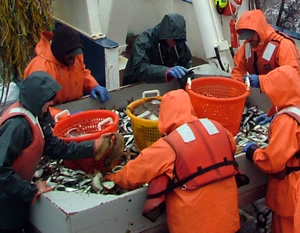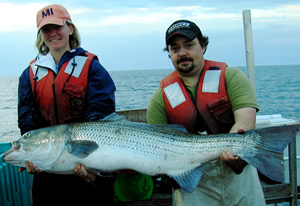 |
A Day On the Ocean Trawl |
|
by Gerald Wilders, Hourly Fisheries Technician
Bureau of Marine Fisheries
May 18, 2016
I receive a call at 8:00 p.m. saying "You're on for the ocean trawl tomorrow, and the departure time from Nacote Creek is 5:30 a.m."
I begin to organize my gear for the morning, making sure that my bib pants, boots, and rain jacket are in the car, and I get to bed early. My mind starts racing with thoughts of the trawl, with hopes that the ocean is not too rough. It's a restless night, and time passes too quickly. The dreaded alarm awakens me at 4:00 a.m. and I know that the day has just begun.
|
The 45-minute drive to the lab on the Garden State Parkway is uneventful, with no deer sightings or major construction delays. My anticipation increases as I turn into the entrance. My fellow crewmembers are also half-asleep but ready for the upcoming day. Everyone tries to get some extra rest during the hour drive to the docks at Cape May. This helps the time go by quickly.
We unload the van, making sure that we didn't forget any of our gear and transport a cooler filled with ice that feels a lot heavier than its 15 pounds! We climb over another boat to get to the Seawolf, an 80-foot research vessel. Chris, the captain, greets everyone from the helm as we climb aboard. Meanwhile, another crewmember, Jason, starts running through the safety information we need to know. I quickly claim a bunk, where I can nap between stations, while breakfast is cooking.
I suddenly awaken to a loud noise signaling that the otter trawl net is going into the water. An otter trawl is a large net with a bag at the cod end where sea life gets funneled into by the movement of the boat. There are two lines on each side of the net with spreaders that keep the net open.
The aroma of eggs and pancakes soon fills the air. I happily eat breakfast and patiently wait. When I hear the gears cranking the doors up, I know it's time to get ready for the catch to come in. I quickly jump into my boots and rain gear. Lastly, I put on my gloves and await the bag coming up.
|
|
The bag breaks the water and we see it; the crew jumps to work and creates an extra wall as this will be a big catch. It's larger than the sorting bin situated in the middle the deck. Everyone takes a step back in case a shark or ray comes over the top onto the main deck. We're awestruck by the sheer mass of the catch.
The fish begin flowing over the boards on the deck. I first see croakers on the floor, and then an angry ray flaps onto the deck. It must be 6 feet wide and 100 pounds! The captain brings down the boom to weigh it and get it back into the water as fast as possible. After that is done, we throw the croakers into bushel baskets and get ready to sort the thousands of fish that are in the sorting box. . After everything is sorted into baskets, we split into two groups for more productive processing.
|
|
One group handles collecting lengths and weights from bulk catches and large fish, including species like skates, rays, dogfish, striped bass, summer flounder, horseshoe crabs, and sea robins. The other group deals with small quantity catches or species that we rarely get, such as shrimp, butterflyfish, pipefish, seahorses, and octopus. There is a brief lull, and then the process begins again.
On a typical day we repeat this process 6 to 8 times depending on the weather and the amount of fish we catch. After a hard day of work I'm tired and happy as we pull into port with the sun setting.
The ocean trawl was designed as an ocean stock assessment survey. Data collected has been compiled over the years by the Bureau of Marine Fisheries to determine statistical data on fish populations. Abundance indices are created for most species. This in turn helps with the stock assessments of many fish, including some that might be endangered or threatened.
In regard to these fish, data from this survey shows whether a fish population is increasing or decreasing in size. This helps to determine if they still should be listed on the endangered or threatened lists. Trawl data is also used to help set fishing regulations by collecting the valuable data that fishery biologists need in order to make informed recommendations.
|
The day is long and hard but the information that we collect is very important to New Jersey biologists and fishermen.
Back to A Day In the Life Of a Marine Fisheries Hourly
|


